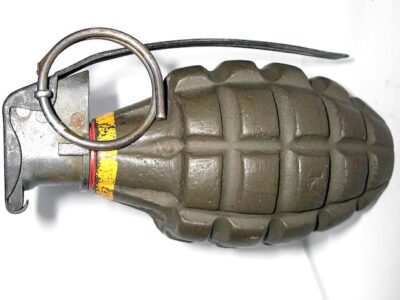Every year, local papers carry sad post-Fourth of July stories about folks injuring themselves with fireworks, despite the pervasive warnings and instructions that circulate in the days and weeks before. Far less common but far more devastating are the occasional tragedies that occur when vintage explosive ordnance is mishandled.
A few years ago, a California school teacher found a 40MM cannon shell while walking along a beach and brought it to school, where he kept it on his desk. One day, while trying to get the attention of his students, he began tapping the shell on his desk. It exploded, severing his right hand.
In May, a 47-year-old Indiana man and his two teenage children were going through their grandfather’s belongings when they came upon a hand grenade, which exploded, killing the father and injuring his two children. Did somebody pull the pin to detonate the grenade? Was it unstable after some 70 or 80 years and explode as it was being handled? We may never know the sequence of events, but there is no doubt as to the tragic outcome.
And, two weeks ago, a woman dug up a WW II anti-tank rocket in her Antioch back yard. Luckily, she called the police, who determined the device was “live” and safely detonated it after evacuating the area.
The moral of these stories? If you ever come across a hand grenade or any other piece of explosive ordnance in your attic or at a garage sale or flea market, don’t touch or play with it, and in the case of a hand grenade, definitely do not pull the pin. If you have no experience with these devices and are not sure what you are dealing with, call your local police department and ask for assistance. They’ll send their EOD (Explosive Ordnance Disposal) experts to you. And do not try to transport the piece to the police department. It could explode en route, and showing up at the police station with a hand grenade is never a good idea.
How common is it to find hand grenades and other pieces of explosive ordnance? Surprisingly, quite common. They made great souvenirs of war because they were generally lightweight and easy to carry and conceal. Large numbers of U.S., German and Japanese hand grenades were brought back by returning veterans. Surplus dealers sold them to the public, and to meet the demand for the novelty “dummy” grenades, were made to look exactly like the originals.
Most hand grenades brought back as souvenirs were rendered harmless. Often the end of the grenade was drilled out, the fuse was inoperable and the explosive charge was removed. Non-lethal training grenades, sometimes, but not always, painted blue, were brought back with their fuses rendered useless. Any device where the explosive charge has been removed and without an active fuse, or primer, is basically harmless (unless you drop it on your foot or bounce it off somebody’s head, of course). They made great paperweights and conversation pieces. Since these were modified so they couldn’t be used as explosive devices, they’re completely legal to possess. But as we’ve recently seen, if you don’t know what you have, they can be deadly. Almost 80 years after the end of WW II, live ordnance still turns up, often with tragic results.
Unexploded ordnance is far more prevalent in other parts of the world, at the sites of major battles. To this day, approximately 2,000 tons of unexploded ordnance are found every year in Germany. These are mostly unexploded aerial bombs and artillery shells dropped by the Allies and uncovered at construction sites. As recently as last month, an unexploded WW II bomb was found in Dresden, which resulted in large-scale evacuations. The threat also extends to the millions of land mines which remain buried and still pose an extreme hazard long after hostilities have ended. All such devices, including hand grenades, should be considered extremely unstable and still capable of causing serious injury or even death.
As always, enjoy your Fourth of July festivities, but leave the fireworks and the explosives to the experts.
— Steve Corbo



0 comments on “A different sort of July 4 safety warning”